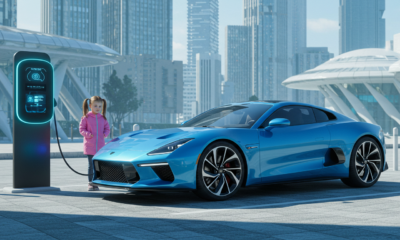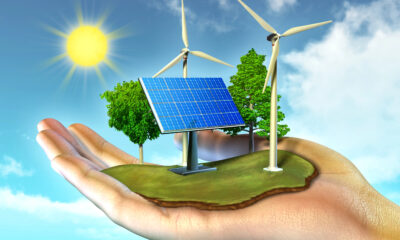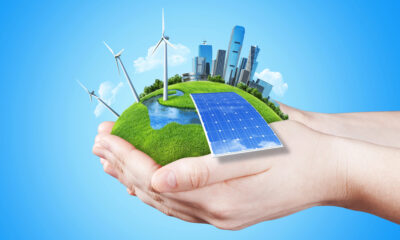Features
Changing the UK Energy Landscape
Juliet Davenport, founder and CEO of Good Energy, tells how Britain can cure its addiction to fossil-fuelled power stations.
The UK has a target to meet by 2050 – to reduce carbon emissions by 80 percent of the 1990 baseline figure. Business as usual is not going to get us there; so fixing our old-fashioned energy supply systems is crucial.
We need to turn our energy systems upside down. For many generations the UK has been dependent on coal, oil and gas, with most of our energy coming from large, centralised fossilfuelled power stations. But concerns are growing, not only about the impact of fossil fuels on climate change, but also about the UK’s growing reliance on imported energy – our energy security. The UK’s energy of tomorrow needs to be drastically different from its energy of today.
Happily, there is an answer: renewable energy. And with our abundant natural resources the UK has the potential to lead a renewable energy revolution. As the windiest country in Europe, and with over 11,000 miles of coastline, we have instant access to an Aladdin’s cave of renewable resources. Even better, these renewable resources are not only abundant, but free, too. By making the most of our wind and tides, as well as encouraging more use of solar photovoltaic and thermal technologies, we could put the UK at the forefront of renewable energy generation.
UK behind in Europe
The UK is committed to a target of 15 percent of energy coming from renewable technologies by 2020. This is equivalent to a seven-fold increase in UK renewable energy consumption from 2008 levels; as currently we generate only 2.2 percent of our power from renewables. Compare this with 44.4 percent in Sweden, 11 percent in France, and 9 percent in Germany and you get the picture. If we are to reach our target of 15% percent we have a serious mountain to climb.
And a good place to start is electricity. Our electricity demand is going up, not down – transport technology is switching towards electric vehicles, and heating and industry are becoming electrified. Electricity demand will double by 2050 according to some forecasts; therefore it is essential that we decarbonise our UK electricity market if we want to keep the lights on.
Role of consumers
Today, electricity constitutes a third of the average UK household’s carbon dioxide emissions. Switching to a 100 percent renewable electricity tariff can be a quick and easy way to reduce our carbon footprint.
Pretty much every energy provider now has a green electricity tariff. But not all green tariffs are created equal. The independent Green Energy Supply Scheme launched earlier this year guarantees the environmental benefit of our green electricity supply, in much the same way as the Fair Trade mark guarantees the ethical provenance of products we buy. It also requires energy suppliers to display their fuel mix – this percentage breakdown of all the different sources of suppliers’ energy is a good indicator of companies’ commitment to renewable energy.
We also need to change how energy is used in the UK. For too long we have taken for granted that, at the flick of a switch, the lights come on. But the more we can reduce our overall energy consumption, the greater the proportion we will be able to supply with renewables. Good Energy believes that understanding where our energy comes from makes us value it more and use it less.
Simple steps – like using energy-efficient light bulbs and making sure our homes are sufficiently insulated –don’t only reduce energy waste but also cut costs. And it’s easy and inexpensive enough to install an energy monitor – being told exactly how much electricity we’re using and when is a great incentive for switching things off. Studies show that households with an energy monitor use an average of 15 percent less energy.
Generate our own
DMR Once we’ve reduced our energy consumption and switched to a 100 percent renewable tariff, what can we do next? How about microgeneration?
Individuals and communities installing small-scale renewable technologies, such as solar panels and small wind turbines, have an important and growing role to play in the UK’s renewable energy future. The energy landscape, once dominated by large, faceless corporations, is being transformed into an energy democracy that supports thousands of independent generators making clean, green energy in homes and communities across the country.
In April 2010 the Government introduced its Feed-in Tariff (FiT), a financial incentive for generating our own renewable electricity. The FiT makes microgeneration much more financially attractive –the scheme income can help to repay any bank loan needed for installation. Payments are inflationlinked for all generators and tax-free for domestic properties. They are also guaranteed for 20 to 25 years, depending on the technology, and paid for total generation, including the units for personal domestic use. Thanks to the FiT, the payback time for an average household with a south-facing roof is now less than 10 years, a reduction that has resulted in an explosion of small-scale renewable energy installations.
Also on the horizon are the Renewable Heat Incentive and the Green Investment Bank, both of which the government has pledged to introduce as part of a raft of green measures. The heat incentive will reward those generating renewable heat, for example by heating water through solar thermal panels and heating homes through heat pumps, while the bank should make it easier for people to invest in renewable technologies.
Towards a 100 percent renewable future
In July 2010 the German government stated that by 2050 it could source 100 percent of its electricity from renewables. Good Energy’s research proves not only that we in the the UK can reach our EU emissions reduction targets, but that we too could be 100 percent renewable by 2050 – and we’ve mapped out a pathway to do it. We need to change UK energy at every stage of the process, from grid management to investment, and from research and development to transport. For example, because renewable electricity comes from Nature’s abundant resources – wind, water and the sun – its output isn’t always predictable. Our systems require massive improvements in how to forecast, store and manage renewable power, and how to back it up. As consumers we also need to develop a new, much closer and more intelligent relationship with the energy we use. It won’t be easy; but a 100 percent renewable future by 2050 is possible.


 Energy12 months ago
Energy12 months agoThe Role of Renewable Energy in Commercial Real Estate

 Environment8 months ago
Environment8 months agoAre Polymer Banknotes: an Eco-Friendly Trend or a Groundswell?

 Energy11 months ago
Energy11 months agoHow Energy Referral Programs are Saving The Planet… And Your Bank Account!

 Environment9 months ago
Environment9 months agoEco-Friendly Home Improvements: Top 7 Upgrades for 2025




























